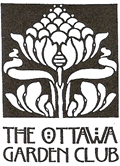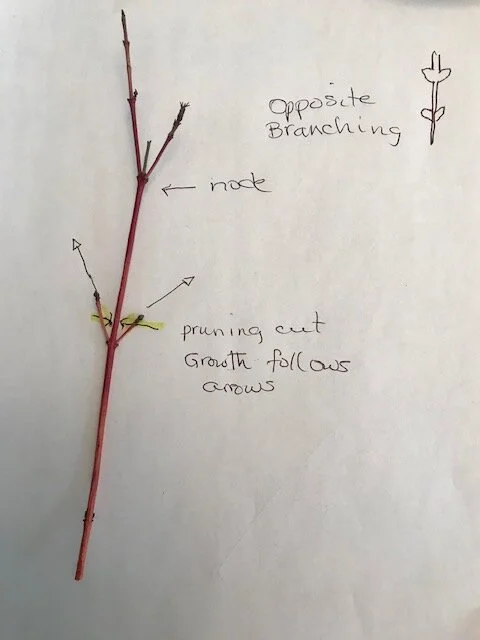By Mary Pratte
The Three D's (and a C) of Pruning Shrubs
You either love pruning, or you hate it! No inbetween... you either look at that tangle of branches in your old lilac as something to which you can easily bring order (ahhhh), or ...as a snakes and ladders type of puzzle which leaves you wondering...where do I start??!!
Well let’s try to be methodical about this. Pruning really is quite easy and satisfying when done properly. First thing to do is to take a really good look at the plant you want to prune so you have a plan. Look at it often, imagining what it will look like with various branches removed. It is best to do this when there are no leaves, but the actual time of pruning you choose depends on the flowering time of the plant. Let's use an old lilac (spring bloom) and a PG Hydrangea (fall flowers) as examples. Now let's apply the three D's (and the C) of pruning.
You want to prune out the Dead, Damaged and Diseased wood.
-The dead because it clutters the plant, can be a safety hazard if, say, a branch might fall and hit someone, and because it can harbour pathogens or insects. To check if a branch is dead, scrape off a tiny bit of the bark with your fingernail or your secateurs, and if there is green underneath, it is merely dormant. Any other colour means the branch is dead. Other things, such as peeling bark, or fungus growth can also indicate that a branch is dead.
-Damaged branches should be removed because they might be weakened even though they still show some healthy growth. It is really a matter of redirecting nutrients to healthy tissue found in the rest of the plant, while removing branches which will not grow well over time. Don't be afraid to take off the weak branches. It will benefit the plant in the long run.
-Diseased material obviously needs to be removed as diseases and viruses can spread quickly (don't we know that!) and can even kill a plant or disfigure it if you don't move quickly.
I like to add the C ...Crossing...when you remove crossing branches, this opens up the plant to air and light, discouraging dampness at the center of the shrub, and encouraging chlorophyll production through the leaves. It also decreases rubbing of branches which damages the bark and allows insects and disease to enter. When you prune crossing branches, cut above a node which is pointing towards the outside of the plant, and not one which will grow towards the inside of the bush.
Generally, plants which flower, as with lilacs, in the spring and early summer, should be pruned right after blooming, to allow as long as possible for bud set through the summer and fall, and also so you don't remove next spring's buds. PG Hydrangea, on the other hand, blooms late summer/early fall, so should be pruned very early in the spring before the leaves emerge. Done any later, after the leaves have opened, and you cut off the bloom for that year.
Use sharp and clean secateurs to minimize spread of disease. (Don't look at mine......I haven't gotten around to cleaning them in a long while!)
If you are using secateurs, there are basically two types: bypass secateurs, the most common sort, and best one for this type of pruning of fairly small and soft wood; and anvil secateurs, better for hard or dead wood. When positioning bypass secateurs to cut, hold them so the cutting blade is closest to (but not too close - you'll learn to know where with practice) and above the node (bump on the branch where a new branch or leaf will emerge). If you position the flat portion of bypass secateurs - the anvil - closest to the node, the branch tissue at or surrounding the node is often damaged. So, again, the cutting blade should be above the node a bit so surrounding tissue and the node are not damaged. If the cut is too far from the node, this leaves a stump which will die back and leave a possible entrance site for insects or disease.
The above photo shows the cutting blade of the bypass pruners closest to the node, and the anvil away from the node. This is the way to prune!
This photo shows the anvil (the flat part) of the bypass pruners close to the node. This is not the way to prune!
If you are dealing with larger branches, a strong, sharp pair of loppers will do the trick (positioning of the blades is the same as with the bypass pruners) but if you have to cut a much larger branch make sure you buy a sharp folding saw. They are worth their weight in gold as they glide smoothly through wood, cutting both on the push and the pull stroke.
The above photo with alternate branching on a magnolia tree with arrows showing the direction of branching before pruning. Cut is indicated in yellow above the node. The branch below the node will grow out to the right, away from the centre of the shrub in this example.
This photo illustrates opposite branching on a dogwood, with arrows showing growth after a cut is made.
Before you begin pruning, you may want to try out these ideas first. Find some old branches in your yard and practice on them. Find the nodes. See in which direction they will send out leaves or new branches where you cut. See whether your cut will leave a branch gong towards the centre of the shrub or to the outside of it. Try things! You will feel like a pro in no time!
Now you're ready to go!
Stand in front of the bush or small tree to be pruned, and study it carefully. Best to do this when there are no leaves. Take into consideration how you want your plant to look, and apply The Three D's (and C), making sure the plant will be visually balanced, open at the centre, and has no dead or damaged material. You and your plant will be happier after a good prune! (Think of how you'll feel after your next haircut!)




